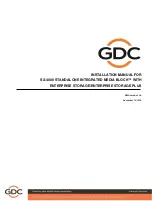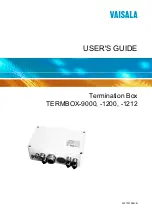
2
|
BT80i Sound Sensor User’s Guide
Short description
The Sound Sensor BT80i is a microphone followed by an internal amplifier. This
microphone is mounted at one end of the box. The sensor measures variations in air
pressure caused by a sound wave. Because of the high sensitivity, the sensor is very
much suited to detect short pressure pulses. This offers the possibility to measure the
speed of sound.
The sound sources that can be used with the microphone are tuning forks, electronic
keyboards, and musical instruments. You may also investigate a human voice or a
whistle. When you use the sound sensor make sure the sound level is in the correct
range to produce good wave patterns. If the sound is too loud, the wave pattern will be
“clipped off” at the top or bottom. In such a case move the microphone further from
the sound source, or turn down the volume of the sound.
By default the sensor measure air pressure in the range between -45 .. 45 Pa.
Additionally, by using the calibration provided in the Coach software the sensor can
measure Sound Level in dB, in the range between 50 .. 110 dB.
The Sound sensor can be directly connected to the analog BT inputs of the CMA
interfaces. The sensor cable BT - IEEE1394 needed to connect the sensor to an interface
is not supplied with the sensor and has to be purchased separately (CMA Article
BTsc_1).
Sensor recognition
The Sound sensor BT80i has a memory chip (EEPROM) with information about the
sensor: its name, measured quantity, unit and calibration. Through a simple protocol
this information is read by the CMA interfaces and the sensor is automatically
recognized when it is connected to these interfaces. If your Sound sensor is not
automatically detected by an interface you have to manually set up your sensor by
selecting it from the Coach Sensor Library.
Calibration
The CMA Sound sensor BT80i is supplied calibrated. The output of the sensor is linear
with respect to the measured air pressure:
p(Pa) = 4.5 * V
out
(V).
Additionally Coach offers the sensor calibration in dB. This calibration is based on the
procedure of determining the average sound pressure p (root mean square average)
and calculating the sound pressure level in decibels from:
L
p
=20 log (p/p
0
) where p
0
= 2.5x 10
-5
Pa.
The Coach software allows selecting the calibration supplied by the sensor memory
(EEPROM) or one of calibrations stored in the Coach Sensor Library. For better accuracy
the pre-defined calibration can be shifted.






















